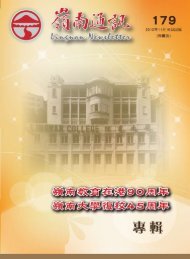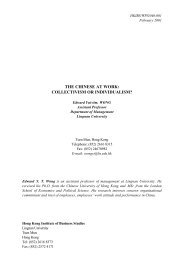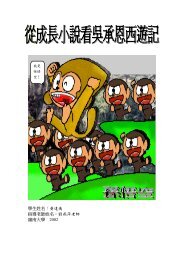Department Of Marketing And - Lingnan University Library
Department Of Marketing And - Lingnan University Library
Department Of Marketing And - Lingnan University Library
Create successful ePaper yourself
Turn your PDF publications into a flip-book with our unique Google optimized e-Paper software.
competitors. Unfortunately, most contents of the advertisements are not totally true. <strong>And</strong> not allcustomers are vulnerable. Therefore, the hypothesis suggests that people who do not trust theadvertisements of weight loss products will rarely buy weight loss products than those who trustthe advertisements. Crosstab (Chi-square) is employed to test the hypothesis.Products No. of people using the weight loss products*Pearson Chi-square Sig. (2-sided)Pills A=21/134 (16%), B=0/3 (0%), C=12/58 (21%) 1.346 0.510Tea A=21/134 (16%) B=0/3 (0%), C=14/58 (24%) 2.637 0.268Food A=24/134 (18%), B=0/3 (0%), C=14/58 (24%) 1.738 0.085(TABLE 19 – The results of attitudes towards advertisements VS buying weight lossproducts)*A = Do not trust the advertisements, B = Trust the advertisementsC = Trust the advertisements, but they feel doubtful.The above results reject the hypothesis. Although there are 134 people who do not trustweight loss products’ advertisements, about 17% of them still buy weight loss products. Whenpeople who less trust the advertisements, about 24% of them tried weight loss products before. Onthe other hand, people have never tried weight loss products before when they totally trust theadvertisements. But the result may not be true since there are only 3 people who trust theadvertisements, it may not be representative.One explanation of the above result is cause-effect relationship. That is, people have triedweight loss products. After taking the products, they may find that the weight loss benefit is not75









